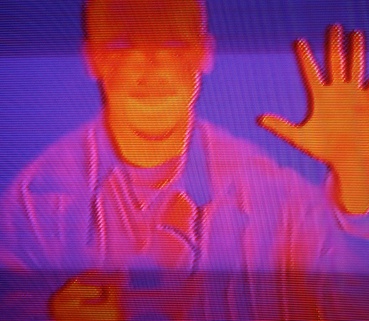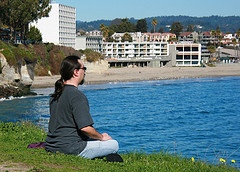Migraine headaches
yield to Meditation

Migraine headaches. No one wants to suffer them! Good news--meditation can help.
On this page, you'll find practical instructions on how to implement this holistic health activity to treat migraines.
Meditation's goal is to produce a deep state of relaxation, a quiet and tranquil mind. Think: calm, peaceful, emotionally stable. No wonder it's been practiced for thousands of years!
What began as the spiritual seeker's tool of exploration has now become the widely held health tool for mental and emotional stress relief...
...whose effects last even after you've finished meditating, and gone back "to real life."
How to Meditate in Daily Life
Try any--or all--of these ideas. They work simply, whether you devote a few minutes or a leisurely half hour to one.
- Deep breaths may work well for you if you're just getting started. Focus completely on your breathing. Feel your chest rise and fall, your belly expand and contract; listen to any sound that's audible. Then, you might try to slow your breaths on purpose.
Sidebar: I'm very verbal, and need to repeat something to myself, like "Innnnnnnn, then ouuuuuuuuuut." I know, sounds ridiculous; but, when your mind wanders, as it will because it likes to be efficient and productive, the most helpful response is to calmly redirect it to the business at hand. I also raise my tongue partway up toward the roof of my mouth, which for some reason makes the breathing louder in my ears. Weird, huh?

- Take a body inventory by paying attention to individual parts of your body in turn. "What's going in my shoulders right now? Oh, they're tense. I'll relax there. Now, how about my calves?" Besides tension, you might become aware of things like warmth, pain, relaxation. Then, add the mental picture of breathing warmth or relaxation into and out of different parts of your body. (My yoga teacher calls this, 'Breathing into those spaces.' Somehow, it works!)
- A mantra is simply a sacred name--or phrase--that you repeat. It can be out loud, or not. Your own mantra works; create one that is meaningful and relaxing for you. Sources for phrases include Scripture, spiritual writings, bits and pieces of philosophy or poetry. As always, find what works for you.
- Then there's the meditation on foot, or simply walking meditation. Any time you're out walking, merely slow down your stride so that you focus on every movement your feet and legs are doing. Think about these body parts themselves, not where you're going. Helpful words to repeat, "lifting" "moving" "placing" when that's what you're in fact doing.
I'll have to give this another try; I think my walking pace was too hurried, and too self-conscious out in public! Let me know how it works for you, too.
- Engage in prayer, the best-known and most widely practiced example of meditation. For a change of pace from spoken prayers, try written ones. Write your own, using spiritual readings for inspiration, or read the ones written by others. Local bookstores have self-help sections or 12-step-recovery materials as a resource. Spiritual leaders are also a healthy resource.
- Read--or listen--then take the time to reflect. Say you read a poem or sacred text silently or out loud, then pause for a few moments to quietly reflect about on the meaning these words brought to mind. You know best what sources will inspire you.
This action reminds me strongly of the ancient spiritual disciplines of silence and solitude. Both are quite rare in our fast-paced world! I think that's what makes this exercise so effective.
- Laser-beam thinking: focus your love and gratitude on a chosen sacred object or being. With eyes closed, you may use your imagination, or gaze at a representation of the object, weaving loving and thankful thoughts, and beaming them outward.
Ever Wonder why it's called "Practice"?

When you start out, be patient! It takes a while to become comfortable with this kind of slow, peaceful activity. For sure, your mind will wander; everyone's does. That's okay! Simply redirect your thoughts toward your intended focal point.
One way to do that: picture balloons floating away, carrying your thoughts with them. Another idea: imagine your thoughts are a dandelion in full bloom, and blow them away. If you're using a visual or physical focus, return your gaze to it, rub it, whatever is helpful.
Meditation with a side-order of...
This is where the fun--and health benefits--begin to build! Meditation can be combined with any of the following, (three of which have pages of more information right here on healthy-alternative-solutions):
When you meditate, you clear your mind of its daily information overload. With this clearer perspective, you're able to find new ways of handling stress and other problems. You begin to live in the present, the here and now, not embroiled in your ever-growing to-do list.
My thanks to the folks at Mayo Clinic
Whether they're nurses, doctors or researchers, those at the Mayo Clinic of Minnesota have my thanks! They're always on the ball, on target for today's health issues, and trustworthy scientifically. Other areas they've helped with include:
As always, I wish you good hunting in your search for effective complementary medicine therapies!
From meditation page to Home Page!